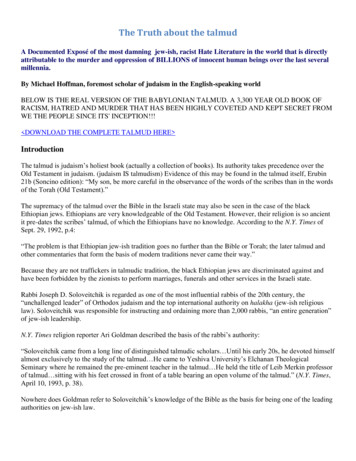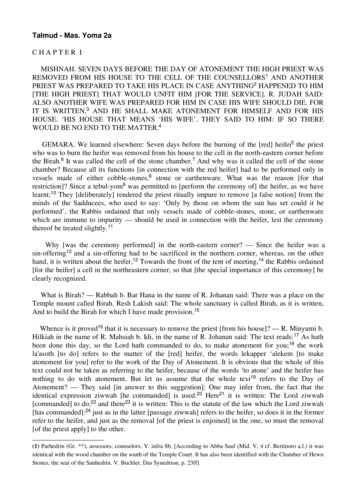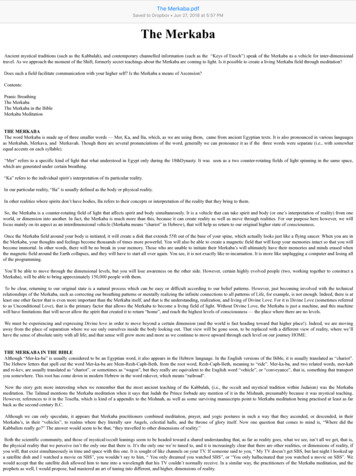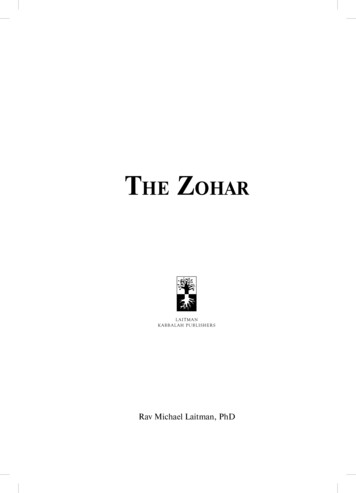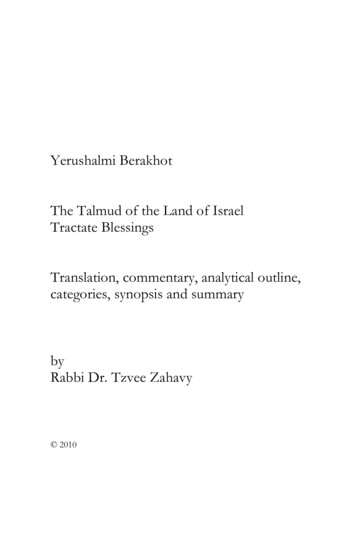
Transcription
Yerushalmi BerakhotThe Talmud of the Land of IsraelTractate BlessingsTranslation, commentary, analytical outline,categories, synopsis and summarybyRabbi Dr. Tzvee Zahavy 2010
ContentsPreface .3Introduction to Berakhot .8Yerushalmi Berakhot Chapter One . 12Yerushalmi Berakhot Chapter Two . 72Yerushalmi Berakhot Chapter Three . 121Yerushalmi Berakhot Chapter Four . 159Yerushalmi Berakhot Chapter Five. 201Yerushalmi Berakhot Chapter Six . 230Yerushalmi Berakhot Chapter Seven. 262Yerushalmi Berakhot Chapter Eight . 289Yerushalmi Berakhot Chapter Nine. 316Analytical Outline of Yerushalmi Berakhot . 365Categories of the Units of the Tractate. 366Synopsis of the organization of the tractate's units . 367Summary of the Tractate's Units . 3952
PrefaceThis book makes available the first English translation in the past onehundred years of Berakhot, the opening tractate of the Talmud of theLand of Israel (Yerushalmi, Palestinian Talmud), composed in the Land ofIsrael at the beginning of the fifth century C.E. I call this translationpreliminary because the state of scholarship on Yerushalmi texts is still atan early stage. The lack of lexicographic, philological, and text-criticaltools for these texts necessitates that I qualify and label provisional anyeffort at systematic work of history, history of religion, or translationbased on the texts of Yerushalmi. Fortunately, this translation issomewhat less preliminary than that of other tractates in this series,because modern scholars, such as A. M. Luncz (TalmudHierosolymitanum [Jerusalem, 1907]) and L. Ginzberg (A Commentaryon the Palestinian Talmud, [1941: reprint New York, 1971]), haveproduced some published critical textual and analytical scholarship onBerakhot.I based my translation on the texts of the standard printededitions and not on either a manuscript or critical edition. Nevertheless, Iused and found helpful the critical apparatus of A. M. Luncz in TalmudHierosolymitanum, (Jerusalem, 1907). I also compared the standardprinted text directly with the editio princeps of Daniel Bomberg (Venice,1523), and with the Leiden manuscript, The Palestinian Talmud LeidenMS. Cod. Scal. 3.: A Facsimile of the Original Manuscript (reprintJerusalem: Kedem Publishers, 1970). I checked the text further againstPalestinian Talmud Codex Vatican 133. (reprint Jerusalem: Makor, 1971),and Yerushalmi Fragments from the Geniza. I., edited by L. Ginzberg(New York, 1909, reprint Jerusalem, 1969).Other works also served as assets in my task. Schwab’s nowcentury-old translation of the tractate first into French and then intoEnglish (Le Talmud de Jerusalem (reprint Paris, 1960); The Talmud ofJerusalem, first edition 1886 (reprint New York, 1969), formed animportant basis for my efforts despite the errors and imperfections of thatearly rendition. I also made use of Charles Horowitz’s Germantranslation Der Jerusalemer Talmud in deutscher Ubersetzung Band IBerakhoth (Tubingen, 1975).Among the numerous manuscript variants and traditionsdiscovered in my comparisons of the versions, I have found very few3
places in the tractate where a divergent reading changes the meaning of apassage. I included these few instances in my translated text, indicatingthe source of the variant (R Vatican [Rome], L Leiden, V Venice).In piecing together my interpretation, I consulted manysecondary works and commentaries, including the following: SdeYehoshua, commentary and edition of Y. Benvenisti (Constantinople,1662; reprint Jerusalem, 1972); the commentary of Z. Frankel (reprint1971); of S. Ginzberg (1941); of S. Goren, HaYerushalmi HaMeforash(Jerusalem, 1961); of Y. Tamar, Ale Tamar (Givataim, 1979), as well as thestandard commentaries found in the printed editions of the tractate, suchas Pene Moshe and Sefer Haredim.These commentaries were most valuable for explaining themeaning and background of the legal materials in the text, for explicatingthe larger context of specific laws and discussions, and for providing richcross references to other parallel or related units in Yerushalmi orelsewhere in rabbinic literature. Throughout the translation I have usedMoses Margolies’s commentary Pene Moshe more frequently than anyother secondary source to help explain the meaning of technical, elliptical,or complex discussions. An unattributed explanation in my translationusually rests on the insights of Pene Moshe. Where I rely on theviewpoint of another commentator, who disagrees with or goes beyondPene Moshe in his interpretation, I so specify in the translation.I have added my own brief commentary to my translation ofYerushalmi Berakhot. At the end of each section of Talmud, beforeturning to the next Mishnah selection, I review and summarize theredactional flow of the material just covered and specify the relationshipof the preceding Talmudic units of discourse to the concerns of therelevant Mishnah passage. I hope this effort helps bring into focus moresharply the redactional agendum of the editors of the tractate.Though I strove to convey the original form and meaning of thetext through the translation, and though I based the translation on themajor classical commentaries, the framers of the Talmud never conceivednor intended that their books be perused casually in translation. Iemphasize strongly that, to fully appreciate the linguistic forms and tocomprehend the many nuances of meaning of this complex and elusivetext, one must study it in its original along with the numerous creative andcomprehensive standard commentaries.4
A complete bibliography of manuscripts, editions, commentaries,and scholarly works may be found in Baruch Bokser’s “AnnotatedBibliographical Guide to the Study of the Palestinian Talmud,” inPrincipat (ANRW II. 19.2), edited by Wolfgang Hesse (Berlin and NewYork, 1979).Recent scholarship establishes the basic underpinnings of thepresent translation. My own most relevant work includes:The Mishnaic Law of Blessings and Prayers: Tractate Berakhot. BrownJudaic Studies 88. Atlanta, 1987.Studies in Early Jewish Prayer. Studies in Judaism. Lanham, MD:University Press of America, forthcoming. Especially see the chapters,“The Editorial Structure of the Talmud of the Land of Israel TractateBerakhot,” and “The Synagogue in Mishnah, Tosefta and Yerushalmi.”"A New Approach to Early Jewish Prayer.” In History of Judaism: TheNext Ten Years. Edited by B. Bokser. Brown Judaic Studies 21. Chico,CA: Scholars Press, 1980."Sources for the Seasonal Ritual in the Third through Fifth Centuries.” InProceedings of the Ninth World Congress of Jewish Studies. Jerusalem,1986."Kavvanah for Prayer in the Mishnah and the Talmud.” Chapter 3 ofNew Perspectives on Ancient Judaism. Edited by J. Neusner. Lanham,MD: University Press of America, 1987."Tosefta Tractate Berakhot.” In The Tosefta Translated from theHebrew. First Division. Zera’im. Edited by J. Neusner. New York, 1986.The theory of the present translation follows that of the series asa whole. I strive to adhere closely to the text so that the reader has asense of the structure and balance of the original. Yet at the same time Itry to convey the flow of the legal arguments and debates, the dramaticunfolding of events in stories, and the sensitivities to words and languagein the exegetical texts. My aim is to facilitate a smooth conversationbetween readers and the text so that, without consulting the originalHebrew and Aramaic version, they can appreciate the substantivemeaning and recognize some major aspects of the style of the Talmudictext.5
With this goal in mind, this English translation is molded in manyways by the complex literary style of the document itself. Somecharacteristics of the Talmud in particular required that I employdistinctive techniques in my translation to allow me to be literal in myrendering of the text, to avoid having to paraphrase throughout, and yetto maintain a high level of intelligibility for the English reader.Several distinctive aspects of my translation contribute to makingit more of a colloquy. The text is stylized, as I have indicated above, andsometimes terse to an extreme in its style of expression. Accordingly, Iinterpolate a fair amount of explanatory language into my translation tomake it more comprehensible. This additional explication helps meunpack the laconic linguistic style of the document.By adding explanation within the translation I also expand uponthe progression of ideas, clarify the arguments of the Talmud, defineunfamiliar materials, and generally elucidate the meaning of the text.When adding my own language within the translation, to make it clearwhere the words of the Talmud end and where my explanations begin, Iset off my additional interpolations with brackets, rather than allowingthem to stand as indistinguishable parts of a paraphrased rendition of thetext.I break the text into smaller units and mark these according tothe style of translation as a whole in this series. The original text has littleif any punctuation or division to demarcate where one sentence orthought ends and another begins. In addition, the Talmud abounds indiscussions about legal points and debates with internal cross-referencesand citations. To help the reader navigate through the text and itspathways, to know where one thought pauses or stops and anotherbegins, I demarcate by capital letters each discrete unit of discourse. WithRoman numerals I mark each larger editorial section.Within the text, to easily demarcate frequent citations fromScripture, Mishnah, and Tosefta, and thus make these components of thecomposite Talmudic text more readily visible, I set these passages offfrom the remainder of the text as follows: I put quotations fromScripture in quotation marks; passages from the Mishnah in oblique type(an italic-like type); and citations from Tosefta in boldface. All otherdiscussion provided by the Talmud for the Mishnah-pericope at issue is inregular type.6
These external and internal attributes of my translation enhanceits readability and increase accessibility to the text for the reader ofEnglish who seeks to join into conversation with this rich corpus ofTalmudic thought.My wife, Bernice, encouraged me throughout this project. Shecarefully read and offered criticism to early drafts of this translation. Mychildren, Yitzhak and Barak, inspired my work as I studied parts of thisand other tractates with them every day. I thank also my students at theUniversity of Minnesota, several who served as research assistants, whocontributed in many small but significant ways to the translation.My colleague Lawrence Schiffman, professor of Hebrew andJudaic Studies at New York University, served as a critical reader of thisvolume. His comments saved me from inaccuracies and greatly enhancedthe precision of this translation. I thank him for his kindness in taking thetime and effort to so thoroughly study this tractate and review this book.I bear responsibility for any shortcomings which may remain in thistranslation.I recognize my great debt to my Talmud teachers at YeshivaUniversity’s Rabbi Isaac Elchanan Theological Seminary. I had the honorof studying the Babylonian Talmud as an undergraduate with RabbiGershom Yankelewitz and Rabbi Aharon Lichtenstein and the privilege ofreceiving postgraduate instruction for four years in both the Talmud andShulkhan Arukh from HaRav Joseph B. Soloveitchik.I acknowledge the influence on this translation of the work of myteacher, Jacob Neusner.Tzvee Zahavy7
Introduction to BerakhotTractate Berakhot of the Talmud of the Land of Israel (Yerushalmi) isorganized around tractate Berakhot in Mishnah. More than three-quartersof the Talmud’s materials in the tractate engage in citation andexplanation of Mishnah, or legal speculation and reflection primary toMishnah, or harmonization of two or more passages of Mishnah, or of aMishnah passage with a rule from Tosefta. Accordingly, to introduce thetractate before us we must first focus our attention on the agendum ofMishnah Berakhot.M. Berakhot appears at first to be a somewhat disjointed tractatecomprising disparate units on a variety of loosely related topics. M.’s lawsdeal with the recitation of the Shema, the recitation of the Prayer ofEighteen Blessings, the requirement to recite short blessings before oneeats foods, the collective recitation of blessings after the meal, other rulesfor the dinner, and blessings to be said on other occasions.One common concern lends coherence to the laws and rules ofthe tractate. That basic unifying principle is the idea that a person mustrecite one or more formulaic blessings in each instance of religious ritualmentioned in the tractate. Hence the title: “Berakhot,” “Blessings.”Accordingly, M. rules that before and after the recitation of thebiblical verses that comprise the Shema, one recites blessings. For dailyprayers, one recites liturgies of eighteen blessings. At meals, one recitesblessings before and after eating any foods. In times of danger, or whenone obtains new clothes, or when one hears good news, or when onecomes into a town from a trip abroad, or in a number of other instances,one recites blessings.Let us summarize the laws of the compilation in order. Thetractate Berakhot in Mishnah begins with the rules for the recitation ofthe Shema and unfolds in seven major divisions as follows:A. Rules for the recitation of the Shema and its blessings (1:1 5)1:1night.1:28Dispute regarding the time for the recitation of the Shema atDispute regarding the recitation of the Shema in the morning.
1:3Houses’ dispute over the exegesis of Deut. 6:7. Scriptural basisfor reciting evening and morning.1:4The rabbinic blessings which frame the Shema. General rulesregarding forms of blessings.1:5Scriptural basis for reciting the last verse of the Shema at night.B. Concentration during the recitation. Social status and the recitation ofthe Shema (2:1-3:6)2:1 2 Intention needed for reciting. Distractions from reciting. Thebasis for the order of the paragraphs.2:3One who erred in reciting.2:4Special rule for craftsmen. May recite atop a tree. It is nodistraction for them.2:5 7 Bridegroom exempt from the Shema. He is distracted.Gamaliel’s practice and two more units about Gamaliel.2:8Bridegroom has the option to recite.3:1 2 Those involved in a funeral are exempt from the Shema.3:3Women, slaves, and minors are exempt from the Shema. Theirother obligations.3:4One for whom the rabbis declared uncleanness (because of abodily discharge) may not recite the rabbinic blessings before and after theShema and before the meal.3:5Related rules: prayer-obligation of one who remembered he wasunclean. Reciting the Shema while unclothed. Prayer near human wastes.3:6Others who are unclean from a discharge must dip in a poolbefore they can recite the Shema.C. Rules for the recitation of the Prayer of Eighteen Blessings (4:1 5:5)4:14:24:34:44:54:64:75:15:25:35:4The times of day to recite the Prayer.Special Prayers for a study hall.Dispute regarding the Prayer of Eighteen.Fixing Prayer. Short Prayer to be said in a place of danger.Direction to face when praying.One who prays when traveling.The Additional Prayer.The frame of mind needed for Prayer.Insertions in the Prayer.Rules for one who makes errors in praying.The priestly blessing during Prayer.9
5:5Prayer recitation as an omen.D. Rules for food blessings and the blessings of the meal and dinner (6:18)6:1The basic taxonomy of categories of foods and their respectiveblessings.6:2Reciting the wrong blessing.6:3Blessings over nonagricultural or defective foods.6:4Priorities of foods for reciting blessings.6:5Reciting a blessing over one food exempts another from the needfor a blessing.6:6One person’s blessing exempts another person from theobligation to recite a blessing.6:7Primary and secondary foods in the meal.6:8The blessings recited after eating. The blessing for drinkingwater.E. The invitation to recite the blessings after a meal (7:1-5)7:1 27:37:4 5The call to recite the blessings after the meal. Who may becounted in the necessary quorum.The formula of the invitation.How a group may separate or combine for the invitation. Theblessing over wine.F. Dinner rituals (8:1-8)8:1Houses’ disputes regarding the dinner. The order of blessings inthe Sabbath Prayer of Sanctification (Qiddush).8:2The order of washing and mixing the cup at dinner.8:3Placement of the napkin at the dinner.8:4Cleaning and washing after the dinner.8:5The order of blessings in the Prayer of Division (Habdalah) afterthe Sabbath.8:6The blessings over light and spices after the meal.8:7Rule for one who forgot to recite the blessings after the meal.8:8Blessings on wine and meal after dinner.10
G. Other blessings and miscellaneous matters (9:1-5)9:1Blessings for shrines and former places of idolatry.9:2Blessings for astronomical, geological and meteorologicalphenomena.9:3Blessings to recite when acquiring new possessions or for hearinggood or bad news. Vain Prayers.9:4Prayers to recite upon entering a new town.9:5Blessings to recite for good and bad events. Proper behavior atthe Temple Mount. The rabbis ordained the invocation of God’s name.To sum up, A and B cover the nature of the obligation to recite theShema morning and evening (1:1 5); intention which is needed for recitingthe Shema and the kinds of distractions which disrupt the recitation of theShema (2:1 3:2). This material ends with rules for individuals who are notobliged to recite the Shema or its blessings (3:3 6).C turns to the second daily liturgy, the Prayer, and deals with: the times(4:1) and forms of the Prayer (4:3 4), one’s orientation during Prayer (4:56), the additional Prayer (4:7). Interpolations into this Mishnaic unit dealwith the short special Prayer for the study hall and for places of danger(4:2, 4:4). It turns then to the frame of mind one needs for the Prayer(5:1) and to other regulations.D covers food blessings (6:1 7), E addresses the blessings after the meal(6:8, 7:1 5), and F deals with dinner regulations (8:1 8). G concludes withrules for special blessings.The Mishnah tractate’s loose substantive conceptual internal coherence isgiven its unity through the perspective of the editor who brought togethera variety of subjects which share in common one practice: the recitationof the rabbinic blessing formula in each of these instances of daily activity.I spell this out at length in my study, The Mishnaic Law of Blessings andPrayers: Tractate Berakhot (Atlanta, 1987).11
Yerushalmi Berakhot Chapter One1:1[A] From what time do [people] recite the Shema in the evening?[B] From [after sunset, that is] the hour that the priests enter [theTemple court] to eat their heave offering,[C] “[They may recite the Shema at any time thereafter up to threehours into the night, that is,] until the end of the first watch [in theTemple],"[D] the words of R. Eliezer.[E] And sages say, “[They may recite the Shema] until midnight.”[F] Rabban Gamaliel says, “Until the break of day.”[G] Once [Gamaliel’s] sons came from the banquet hall.[H] And they said to him, “We have not [yet] recited the Shema.”[I] He said to them, “If the day has not yet broken, you areobligated to recite [the Shema].”[J] And it is not only [in] this [case that the sages] said [that onemay perform a religious obligation until daybreak]. But regardingall cases in which the sages said [that one must carry out hisobligation] “until midnight,” [if a person should perform] thereligious obligation by daybreak [it is acceptable].[K] [For example, one may acceptably perform the obligation to]offer the fats and entrails [of sacrifices in the Temple and to eat thepaschal sacrifices] until the break of day.[L] [Another example:] All [sacrifices] which must be eaten withinone day [i.e. before midnight of the day they are offered], theirobligation [may legitimately be carried out and they may be eaten]until the break of day.12
[M] If so why did [sages] say [that these actions should beperformed only] until midnight?[N] In order to keep man far from sin.[I.A] It was taught [in the Mishnah], [People may recite the Shema aftersunset, that is] from the hour that the priests enter [the Temple court] toeat their heave offering.[B] R. Hiyya taught, “[They may recite the Shema] from the hour thatpeople are accustomed to enter [their houses] to eat their bread onSabbath eve,” [the words of R. Meir. (Regarding the recitation of theShema, when does night begin?) An indication for (when night begins is)the emergence of the stars.] [Tosefta Ber. 1:1.][C] And it was taught regarding these rules [in A and B]: These opinions[in M. and T.] are nearly identical.” [That is, they refer to the same time ofday.][D] But observe [by way of objection that M.’s rule appears to conflictwith T.’s law]: From the hour that the priests enter [the Temple court] toeat their heave offering [is right after the end of] the day [i.e. before thetime that people enter their houses to eat the meal on the Sabbath].[E] But [T. rules that one may recite the Shema from] the hour thatpeople enter [their houses] to eat their bread on Sabbath eves [which] isafter [the emergence of the] stars, that is already an hour or two into thenight![F] And yet you say that, “These opinions are nearly identical!”[G] Said R. Yose, “[This apparent contradiction between M. and T.] maybe resolved [by explaining that Tosefta’s ruling refers to a special casewherein people return home early, i.e., those residents of] small villageswho leave [their weekday work and return home] while it is still day, whoprepare [and eat their Sabbath meals] while it is still early. [P.M. Underthese circumstances the rulings of M. and T. do not disagree. They referto nearly identical times of day. According to both rules, one may recitethe Shema right after sunset.]”13
[II.A] It was taught: One who recites [the Shema] before the time [thatthe priests enter the Temple court at sunset to eat their heave offering, cf.M. 1:1B] does not [thereby] fulfill his obligation [to recite the Shema].”[B] If so why do they recite [the Shema] in the synagogue [where they saythe service while it is still day]?[C] Said R. Yose, “They do not recite it in the synagogue in order tofulfill the obligation [to recite the Shema]. Rather [they recite the Shemain the synagogue] so that they will rise to [recite] the Prayer [of Eighteenblessings] after speaking the words of Torah [that comprise the passagesof the Shema].”[III. A] R. Zeira in the name of R. Jeremiah, “If one had a doubt whetheror not he had recited the grace after his meal, he must recite the grace,[B] “for it is written, “And you shall eat and be full, and you shall bless[the Lord your God for the good land he has given you]” [Deut 8:10].[Since the obligation to recite the grace after meals is derived from a versein Scripture, if one had any doubt whether he had recited it, he must saythe grace forthwith. The principle behind this reasoning is: one must beespecially scrupulous in any case of doubt concerning the performance ofan obligation based directly on a verse in Scripture.][C] “But if one was in doubt whether he had recited the Prayer [ofEighteen blessings], he need not recite it [for it is a rabbinic obligation,not derived directly from a verse in Scripture. And the correspondingprinciple is that one need not be as scrupulous regarding such anobligation.]”[D] But this rule [that one need not recite the Prayer in a case of doubt]does not accord with the view of R. Yohanan. For said R. Yohanan, “Butoh, that a person might [have the opportunity to] pray all day long.”[That is to say, nothing is lost by repeating the Prayer.][E] Why [does Yohanan say that one may pray all day long]? Becauseprayer never loses its value [cf. Y. to M. 4:4, section III].[F] [In light of this distinction, Y. poses a question.] If one was in doubtwhether or not he had recited [the Shema, what is the ruling? Must herecite it or not?]14
[G] Let us deduce the answer from the rule [stated above at II, A]: “Onewho recites the Shema before the time [that the priests enter the Templecourt at sunset to eat their heave offering] has not fulfilled his obligation[to recite the Shema].”[H] Is it not [reasonable to draw the following conclusion:] [The phrase]“before the time [that the priests enter]” [may be understood to refer toand include] a case in which one was in doubt [whether he had fulfilledhis obligation to recite the Shema. How so? For instance, the phrase mayrefer to a case of one who recites the Shema at the moment of sunset andis not sure whether at that time it is day or night.][I] Yet [in such a case] the rule is, “He must recite [the Shema againbecause by reciting it too early he may not have fulfilled his obligation torecite it at night].” It then follows that [we may state a general rule on thebasis of this reasoning]: “If one was in doubt whether he had recited [theShema], he must recite it.”[IV.A] [With respect to the obligation to recite the Shema, when doesnight begin?] We may find an indication concerning this [in the verse]:“Until the stars come out . . . “ (Neh. 4:21). Even though there is noproof [in Scripture that night begins when the stars come out], there is anallusion [in the verse,] “So we labored at the work and half of them heldthe spears from the break of dawn until the stars came out (Neh. 4:21).”[T. 1:1 E F.][B] And it is written, “[Let every man and his servant pass the nightwithin Jerusalem,] that they may be a guard for us by night and may laborby day (Neh. 4:22).” [They labored until night, i.e. when the stars cameout. These verses thus imply that it is night when the stars come out.][C] How many stars must come out so that it is deemed night?[D] R. Pinhas in the name of R. Abba bar Pappa, “[If one sees] one star,it is certainly day. [If one sees] two [stars], there is doubt [whether it is]night. [If one sees] three [stars], it is certainly night.”[E] “[If one sees] two [stars], there is doubt.” [Why is there any doubt?]For it is written, “Until the stars came out! (Neh. 4:21).” The minimumnumber of stars [plural] is two. [After two stars come out it should bedeemed night.]15
[F] [There is doubt because] we do not count the first star of the evening,[for when it appears, it is deemed still to be day. Hence when two starsappear it still may be day. We therefore must wait for three stars toappear before we deem it to be night.][G] [It was taught, in support of Pinhas’ teaching at D:] On the Sabbatheve, if one saw a single star and then unintentionally performed laborwhich is forbidden on the Sabbath, he is free [from any liability because itis still day]. [If one saw] two [stars and unintentionally performed an actforbidden on the Sabbath,] he must bring a suspensive guilt offering [i.e. asacrifice offered in a case of doubtful transgression, because we do notknow whether he transgressed the Sabbath]. [If one saw] three [stars andperformed an action which is forbidden on the Sabbath], he must bring asin offering [because we are sure that night has fallen and that he hastransgressed a Sabbath prohibition].[H] [Analogously,] at the end of the Sabbath, if one saw a single star andthen [unintentionally] performed labor which is forbidden on the Sabbath,he must bring a sin offering [for it is surely still the Sabbath day]. [If onesaw] two [stars and he unintentionally performed a forbidden act], hemust bring a suspensive guilt offering [for we do not know if it was day ornight, and, accordingly whether he transgressed a Sabbath prohibition].[If one saw] three [stars and unintentionally performed some act whichwould be forbidden on the Sabbath], he is free [from any liability for itsurely is night and the Sabbath has ended. This discussion supportsPinhas’ premise that we determine the onset of nightfall by counting thenumber of stars which one can see].[I] R. Yose b. R. Bun speculated, “If we say ‘[If one saw] two [stars], thereis a doubt,’ [then consider the following case in which a person certainlywould be liable for transgressing a Sabbath prohibition even if heperformed a forbidden act during the time that only two stars were visiblethat period of doubt at either the beginning of the Sabbath on Fridaynight or at the end of the Sabbath on Saturday night:] One saw two starson the Sabbath eve [just at the time of nightfall] and witnesses warnedhim [that labor is forbidden on the Sabbath] and [nonetheless at that time]he performed forbidden labor. Then he saw two stars at the terminationof the Sabbath, and they warned him, and [nonetheless again] heperformed forbidden labor.[J] Any way you look at it [he should be guilty of transgressing a Sabbathprohibition, because he was duly warned and then he deliberately16
performed a forbidden labor on the Sabbath according to the followingreasoning:][K] For if [we determine that] the first [two stars he saw at the beginningof the Sabbath were deemed to be seen] in the day, then [we concludethat] the last [two stars which he saw at the end of the Sabbath also weredeemed to be seen] in the day. And [therefore] he should be liable [fortransgressing a Sabbath prohibition] by virtue of [performing a forbiddenact during the Sabbath day while] the last [stars which he saw just prior tothe end of t
English (Le Talmud de Jerusalem (reprint Paris, 1960); The Talmud of Jerusalem, first edition 1886 (reprint New York, 1969), formed an important basis for my efforts despite the errors and imperfections of that early rendition. I also made use of Charles Horowitz’s German translation Der Jerusalemer Talmud in deutscher Ubersetzung Band IFile Size: 1MBPage Count: 401
